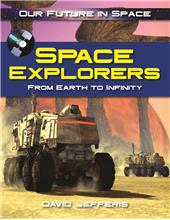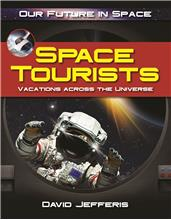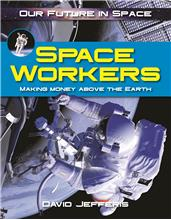| ________________
CM . . . . Volume XXIV Number 24. . . . February 23, 2018
excerpt:
Four titles comprise the new “Our Future in Space” series which not only covers what is currently being done in the field of space travel and exploration, but the series also speculates what the future might bring. Each book, written in a question-and-answer format, with a paragraph or two devoted to the answer, has 13 chapters. Science buffs will find the information very interesting, although much of it is quite technical, and there are so many facts, acronyms and small details that it is difficult to retain them all. A great deal of the information is speculative as scientists work on the challenges of designing vehicles, drones and probes for the varied environments of outer space. Text boxes provide additional facts while “What Do You Think?” boxes pose questions which require some critical thinking by the reader. One example is a question which asks if it seems fair that space travel, which is so expensive, will be a luxury only available to the extremely wealthy. Illustrations consist of photographs, models and drawings as well as some renderings of futuristic space vehicles, homes and communities. A table of contents, a glossary, an index and a list of websites for further study are included. Space Colonists explains that the main focus of scientists at present is the colonization of the moon and planet Mars. Inherent in this focus are the challenges, such as the unknown long-term effects of the moon's gravity on the human body which could limit the amount of time that humans spend on the moon. Travel to Mars is also contemplated, with NASA researchers working on 'torpor” technology which is similar to hibernation. Torpor would allow people on board the spacecraft to spend much of the long trip to Mars in deep sleep. It is estimated that a crewed Mars landing could occur as early as the year 2030. An interesting aspect of space travel is the ability of astronauts to use 3-D printers to create any tools on board the spacecraft on an as-needed basis instead of the expensive prospect of flying the tools from Earth. Other topics in this title include the International Space Station (ISS), the creation of a moon colony, life and survival on the moon and Mars, the role of robots in creating the first base on Mars, the possibility of life on Venus, asteroid mining, and the costs associated with space travel and colonization. In 1957, Sputnik I, the first artificial satellite was launched into space, but man has never ventured farther than the moon. Space Explorers features past history of space missions as well as current projects and some of the companies, such as SpaceX and Blue Origin, that are working on designs that could some day carry as many as 100 people into space at a time. The development of new types of spacecraft, space telescopes, probes and roving vehicles to collect rock and soil samples are also discussed in this title. Researchers are studying planets to determine whether or not water is present so that life on these planets can be sustained. And, of course, each planet or its moons has different challenges owing to variations in temperature and atmospheric pressure, but the first order of business is just getting to the space destination. For example, nearly half of all robotic missions to Mars have failed to arrive. People have been fascinated with life on other planets for many years. In 1952, artist Frank Hampson drew a picture of a hotel on Mars, the details of which were based on sound science. By the early 2000s, seven space tourists stayed on the ISS for a week at a cost of $20-40 million each. Space Tourists looks at some of the training required of the travellers prior to the flight as well as what life is like aboard the craft. Food, for instance, is pre-packed frozen or freeze-dried, and for now, bread, other than flatbread, is taboo due to the danger of crumbs being breathed in or clogging equipment as they float through the spacecraft. Readers will learn that space starts at the Karman line, about 100 km from Earth. Blue Origin and Virgin Galactic already fly passengers there at a cost of $250,000 per ticket, which is 100 times cheaper than a week's stay on the ISS. This title also includes plenty of examples of spacecraft that could be used for tourism, with or without crews. There is a lot of conjecture here. The biggest space-related money-maker is the manufacture, launch and operation of artificial satellites. A satellite's price tag depends on a number of factors (size, type, and location of orbit), but it could be up to $325 million which includes manufacturing, launching, launch insurance, space insurance and 15 years of operating costs. One of the best known satnav (satellite navigation) satellites mentioned in Space Workers is GPS (Global Positioning System) which consists of 30 satellites, each of which sends out a radio signal to mobile devices to determine one's location. Other topics in this title include aerospace machines, such as carrier planes and engines, reusable rockets, robots, 3-D printing, space suits, mining on the moon, medical issues in space, and problems with space debris. Though the "Our Future in Space" series is highly speculative, the books' contents are based on current explorations and research. The question-and-answer format works well since the information can be very technical. It is this technical aspect that might limit audience size. Recommended. Gail Hamilton is a former teacher-librarian in Winnipeg, MB.
Next Review |
Table of Contents for This Issue
- February 23, 2018. |



